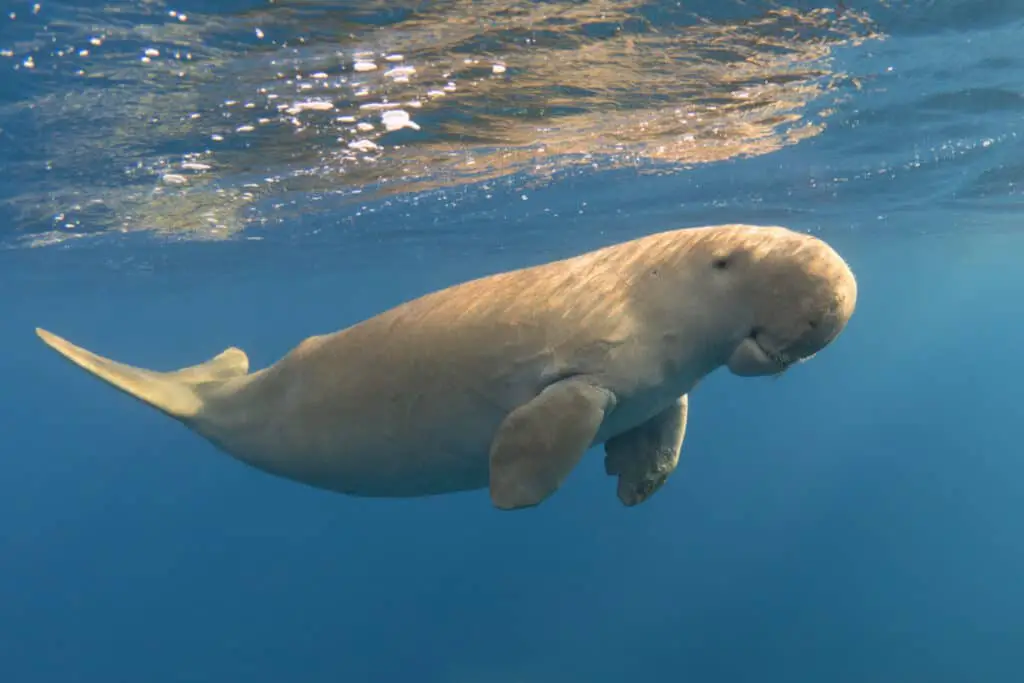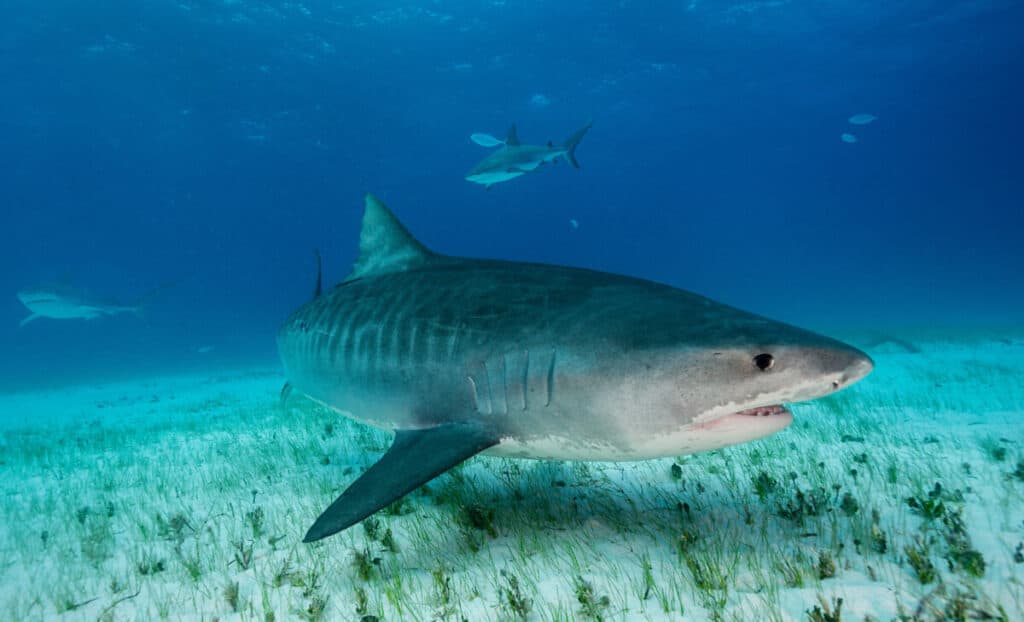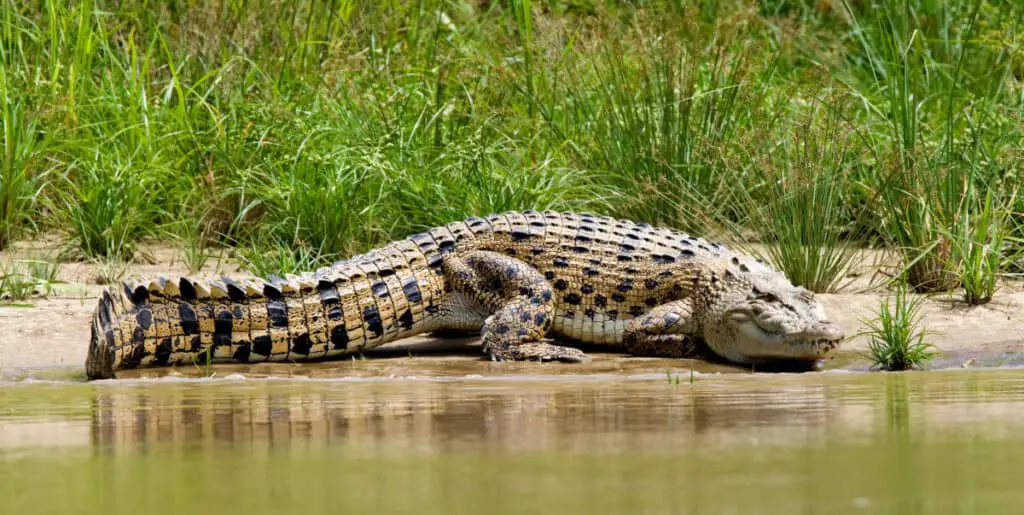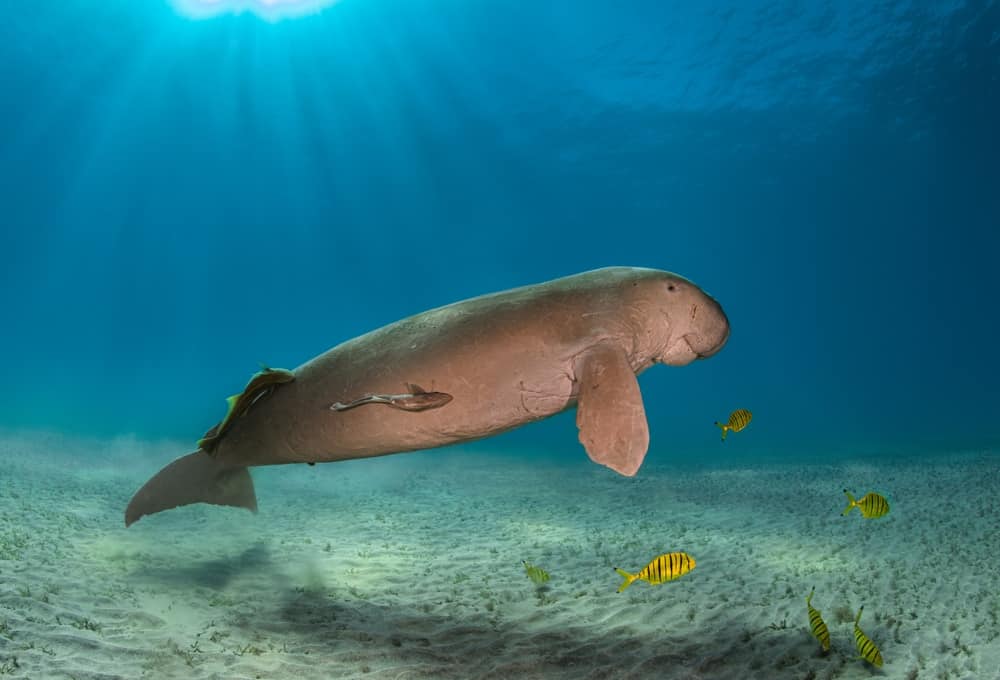The dugong is a marine mammal that belongs to the Sirenia order. These animals are known for their unique appearance and gentle nature, making them a popular attraction in many coastal areas around the world. Despite their peaceful demeanor, dugongs still face threats from various predators that prey on them.
Understanding the predators of dugongs is essential for conservation efforts aimed at protecting these creatures. By identifying the natural enemies of dugongs, researchers can develop effective measures to mitigate human-induced factors such as habitat loss or disturbance that have led to declining populations of this species.
Therefore, this article aims to provide an overview of some common predators of dugongs, including both natural and anthropogenic factors affecting their survival.

The Natural Enemies Of Dugongs
The natural enemies of dugongs are primarily sharks, crocodiles, and killer whales. Dugongs can fall prey to these predators when they venture into deep waters or estuarine areas where their food sources may be more abundant.
Threat mitigation measures such as the use of protective barriers and anti-predator devices have been implemented in some regions to reduce the risk posed by these animals.
In addition to addressing the threat from natural predators, habitat restoration efforts are also crucial for the survival of dugong populations. The destruction of seagrass beds due to human activities such as coastal development and pollution has led to a decline in the availability of food for dugongs.
By restoring degraded habitats, including those that have been damaged by storms or other disturbances, we can help ensure that there is sufficient food available for these marine mammals and reduce their vulnerability to predation.

Tiger Sharks
The Natural Enemies of Dugongs have always been a concern for scientists and wildlife enthusiasts. These gentle marine mammals are herbivorous, meaning they mainly feed on seagrass. Their large size and slow movement make them vulnerable to predators in their natural habitat, which includes shallow coastal areas such as bays, lagoons, and coral reefs.
Some of the common dugong enemies include crocodiles, killer whales, saltwater crocodiles, and sharks. Among all these predators, tiger sharks (Galeocerdo cuvier) pose a significant threat to the survival of dugongs. Tiger sharks are one of the most dangerous shark species globally and can grow up to 5 meters long.
They have broad diets that include various prey like turtles, dolphins, stingrays and dugongs. Due to increasing water temperatures associated with climate change leading to migration changes in some fish populations- this may impact the distribution of tiger sharks. As their habitats move or shrink due to environmental factors caused by global warming – it is possible that more tiger sharks will start preying on dugongs than ever before.
Sirenians in Peril: Why We Must Preserve These Unique Creatures

Saltwater Crocodiles
Saltwater crocodiles are known to be one of the most fearsome predators in their habitat. These large reptiles can weigh up to 1,000 kg and grow up to 6 meters long. They have an impressive hunting prowess which makes them a danger not only for humans but also for other animals living in their territory.
In fact, saltwater crocodiles are considered as ambush predators of dugongs. Dugongs live in shallow coastal waters across the Indo-Pacific region where they feed on seagrass beds. Their habitats include areas that overlap with those of saltwater crocodiles.
Crocodile behavior is opportunistic, meaning they will prey on any animal within their reach if given the chance. Dugongs are slow-moving creatures and often graze in open waters making them vulnerable to attacks from these apex predators. Saltwater crocodiles use stealth tactics when attacking dugongs; they wait patiently underwater until their prey approaches before launching a surprise attack from below.
Due to this modus operandi, many dugong carcasses found show signs of being attacked by crocodiles without having a chance to defend themselves.
Manatees and Their Predators: Revealing the Threats

Killer Whales
Killer whales, also known as orcas, are one of the few animals in the ocean that can take on a fully grown adult dugong.
Orca vs. dugong encounters demonstrate the complex predator-prey dynamics in marine ecosystems.
Killer whales are apex predators and have been observed attacking dugongs by flipping them over onto their backs to immobilize them before delivering fatal bites to vital organs such as the heart and lungs.
However, these attacks are rare as orcas prefer hunting other marine mammals like seals and dolphins.
In fact, scientists believe that killer whale populations may be negatively impacted by declines in prey species due to overfishing and pollution.
Despite this, it is important to continue studying predator-prey relationships in order to better understand how changes in marine ecosystems affect different species.
Human Threats To Dugongs
Apart from natural predators such as sharks and crocodiles, dugongs face a range of human-induced threats that significantly impact their population.
These include the impacts of fishing activities such as bycatch in nets and direct hunting for meat and oil.
Overfishing also reduces the availability of seagrass beds, which is the primary food source for dugongs.
Pollution resulting from coastal development, sewage discharge, oil spills, and marine debris ingestion further exacerbates these issues.
These threats have led to a significant decline in dugong populations globally.
The International Union for Conservation of Nature (IUCN) lists them as vulnerable to extinction.
However, there is hope for their conservation through collaborative efforts with indigenous communities who have been stewards of dugong habitats for generations.
These communities play an essential role in protecting seagrass meadows and implementing sustainable fishing practices that minimize harm to dugongs while ensuring food security for local households.
By supporting these communities’ efforts and addressing the root causes of threats facing dugongs, we can safeguard this magnificent species from extinction.
To ensure the preservation of dugongs, four critical actions must be taken:
- Implement policies that regulate unsustainable fishing practices.
- Reduce pollution on coastlines.
- Support initiatives aimed at conserving seagrass beds.
- Empower indigenous communities living around dugong habitats to take on leadership roles in conservation efforts.
Family Trichechidae: Exploring the Fascinating Realm of Manatees
Conservation Efforts To Protect Dugongs
Human-induced threats to dugongs can have a significant impact on their populations, but natural predators also pose a danger. Dugongs are primarily hunted by sharks and crocodiles, with some reports indicating that killer whales may also prey on them in certain areas. While these predators play an important role in maintaining balance within the ecosystem, human activities such as overfishing and habitat destruction can exacerbate the threat they pose to dugongs.
Effective strategies for protecting dugongs from both human-induced threats and natural predators require community involvement. This involves engaging local communities in conservation efforts through education programs, alternative livelihood initiatives, and sustainable fishing practices. By working together with stakeholders at all levels, it is possible to develop solutions that prioritize the needs of both people and wildlife while ensuring the long-term survival of dugong populations. The table below provides examples of successful projects aimed at conserving dugongs by empowering local communities:
| Project Name | Location | Objectives |
|---|---|---|
| Project Seagrass | Indonesia | Promote seagrass habitats by involving coastal communities in restoration efforts |
| Dugong Conservation Network | Australia & Pacific Islands | Support research, monitoring, and awareness-raising activities among indigenous communities |
| Bazaruto Archipelago National Park | Mozambique | Engage fishermen in marine resource management plans |
Through collaborative conservation approaches like these, we can create a future where humans and dugongs coexist sustainably.
Diving into the Sensory World of Dugongs: How Good Are Their Senses?

The Future Of Dugongs And Their Predators
The future of dugongs and their predators is a topic that requires careful examination, given the numerous threats facing these marine mammals. One of the most significant impacts on dugong populations in recent years has been climate change. As sea surface temperatures continue to rise, seagrass beds – the primary food source for dugongs – are becoming less abundant, forcing these creatures to travel greater distances in search of sustenance. This increased exposure makes them more vulnerable to predation, as well as collisions with boats and other vessels.
Despite this bleak outlook, it’s important to remember that dugongs are not just another species struggling to survive in today’s changing world; they also play a vital role within many ecosystems as a keystone species. Their grazing habits help maintain healthy seagrass meadows, which provide habitat and food for countless other organisms such as green turtles and manatees.
Therefore, preserving dugongs should be viewed not only as an ethical imperative but also as a crucial step towards maintaining ecosystem health in our oceans.
In light of all these challenges facing dugongs and their predators, there remains much work to be done by conservationists around the globe. Whether through reducing carbon emissions or establishing protected areas where these animals can thrive without human interference, we must act quickly if we hope to save these beloved marine mammals from extinction.
The future may seem uncertain at times, but one thing is clear: the fate of dugongs and their predators lies in our hands.
Conclusion
Dugongs are an important and vulnerable marine species that face numerous threats from their natural predators, including tiger sharks, saltwater crocodiles, and killer whales.
Human activities such as overfishing, pollution, and habitat destruction also pose significant risks to the survival of dugongs.
Efforts to conserve and protect these animals include establishing protected areas, reducing human impacts on their habitats, and promoting sustainable fishing practices.
However, continued conservation efforts are necessary to ensure the long-term survival of dugongs and their ecosystems.
Overall, understanding the predators of dugongs is essential for developing effective management strategies that balance the needs of both humans and these unique sea mammals.
By working together towards a common goal of protecting our oceans and its inhabitants, we can help ensure a brighter future for all species living within them.
